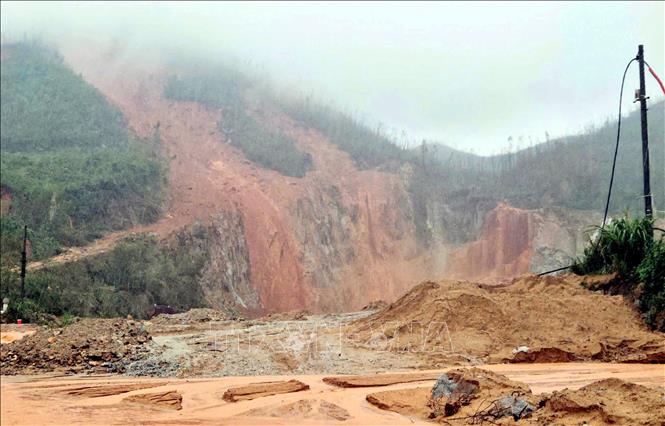
Accordingly, at 4:00 p.m. on November 4, the center of storm KALMAEGI was at about 10.7 degrees North latitude, 121.3 degrees East longitude, in the sea west of the central Philippines, about 770km east of Song Tu Tay island, the strongest wind near the center of the storm was level 13, gusting to level 16. The storm is forecast to move in the West Northwest direction, about 25km/h and is likely to strengthen to level 14, gusting to level 17; when making landfall, the focus of the provinces from Quang Ngai to Dak Lak, gusts of level 14-15; the storm's circulation causes very heavy rain in the provinces and cities from Da Nang to Dak Lak, commonly 200-400mm, locally over 600mm/period.
The area from South Quang Tri to Hue city, Khanh Hoa and Lam Dong has heavy to very heavy rain, commonly 150-300mm/period, locally over 450mm.
This is a very strong storm, after entering the East Sea it continues to strengthen, the area of influence of strong winds is very wide. In the context of the Central region being affected by the historic heavy rain and floods that have lasted for a long time, causing heavy damage.
To proactively prevent and respond to storm KALMAEGI and post-storm floods, ensure people's safety, minimize property damage, coastal and inland, the National Steering Committee for Civil Defense requests ministries, branches and People's Committees of the above provinces and cities to strictly implement the Prime Minister's direction in Official Dispatch No. 208/CD-TTg dated November 4 on proactively preventing, avoiding and responding to storm KALMAEGI.
For sea routes, ministries, branches and localities closely monitor the storm's developments; by all means inform ship owners, captains of ships and vehicles still operating at sea about the range and intensity of the storm so that they can quickly move out of the dangerous area or return to a safe shelter earlier than usual. Dangerous areas in the next 24 hours: From latitude 10.0-14.0N; east of longitude 114.5E (dangerous areas are adjusted in forecast bulletins).
Provinces and cities organize and strictly manage boats at anchorages and shelters; absolutely do not allow people to stay on boats when the storm hits and do not return to boats without ensuring safety, avoiding unfortunate human losses; deploy work to ensure safety of people, vehicles, and property, especially for tourist destinations, aquaculture, fishing, and constructions at sea, on islands, and coastal areas. Based on the specific situation, localities decide to ban fishing boats, transport ships, and tourist boats, in which the ban time is noted to be earlier than in previous storms and urgently evacuate people on boats, cages, watchtowers, aquaculture areas, coastal areas, and low-lying areas.
On land, provinces and cities urgently overcome the consequences of the recent floods according to Official Dispatch No. 206/CD-TTg dated November 2, 2025 of the Prime Minister. At the same time, organize reviews and prepare plans to evacuate households in dangerous areas, especially coastal areas, areas at high risk of landslides, flash floods, low-lying areas, deep flooding to safe places; have plans to support temporary accommodation, food, and necessities for people who have to evacuate, ensuring stable lives for people; prepare forces, means, equipment, and necessities according to the "four on-the-spot" motto to be ready to respond to all situations, especially for areas at risk of being isolated, areas that are overcoming the consequences of natural disasters that have suffered heavy damage in recent times.
Provinces and cities also urgently complete pruning trees, bracing and reinforcing houses; take measures to ensure safety, limit damage to warehouses, headquarters, public works, industrial parks, factories, power grids and telecommunications systems; take measures to quickly overcome traffic, electricity and telecommunications incidents, ensuring operations are maintained in all situations, from areas at high risk of deep flooding to safe places; prepare forces and means for rescue when required; soon have plans and decisions for students to stay home from school before the storm makes landfall and after the storm, urgently mobilize forces to harvest aquatic products and agricultural production with the motto "green at home is better than old in the fields"; organize remote traffic, limit people from going out during storms and heavy rains; be ready to arrange forces to guard and control people and vehicles in areas at risk of deep flooding and landslides; Arrange forces, materials and means to fix problems and ensure smooth traffic on main traffic routes when heavy rain occurs.
At the same time, inspect and review key works, unfinished works, especially small reservoirs that have been full of water due to heavy rains in the area in recent times; direct reservoir owners and relevant agencies to urgently operate water discharge to reserve capacity to receive floods according to regulations, especially in provinces with storms from Quang Ngai to Dak Lak; organize a permanent presence, ready to regulate and ensure safety of works and downstream areas; prepare plans to ensure drainage and prevent flooding for agricultural production areas; deploy forces and means to drain buffer water, clear blockages, and prevent flood discharge, be ready to operate drainage systems for industrial parks, urban areas, and residential areas, and at the same time inform and guide people to raise their belongings, food, and essential supplies to cope with storms, floods, and minimize damage.
Ministries and branches, according to their state management functions and tasks and assigned tasks, proactively direct and coordinate with localities to respond to storms and floods.
The Head of the National Civil Defense Steering Committee assigned the central and local hydrometeorological forecasting agencies to closely monitor the storm's developments and provide full, accurate, and timely forecast information to relevant agencies to serve the direction and response to storms and heavy rains according to regulations.
The above units organize serious duty and regularly report to the National Civil Defense Steering Committee (through the Department of Dyke Management and Natural Disaster Prevention and Control - Ministry of Agriculture and Environment).
At the same time, the Ministry of Agriculture and Environment issued Document No. 8735/BNNMT-DD to the People's Committees of Ha Tinh, Quang Tri, Hue, Da Nang, Quang Ngai, Gia Lai, Dak Lak, and Khanh Hoa provinces and cities on the implementation of work to ensure the safety of the dike system in response to storm KALMAEGI.
To ensure the safety of the dike system and proactively respond to storms, the Ministry of Agriculture and Environment requests the People's Committees of the above provinces and cities to direct relevant agencies and units to urgently and strictly implement Official Dispatch No. 208/CD-TTg dated November 4, 2025 of the Prime Minister and Official Dispatch No. 26/CD-BCĐ-BNNMT dated November 4 of the National Civil Defense Steering Committee on responding to storm KALMAEGI.
Provinces and cities closely monitor the developments of storms, floods and the situation of dikes and embankments. Check, review and implement dike protection plans, protect key vulnerable points, especially dikes and embankments facing the sea; organize the handling of landslides to limit damage when storms make landfall.
Localities are ready with human resources, materials, vehicles and equipment to protect the dikes according to the "4 on-site" principle, ensuring the safety of the dikes, and promptly reporting dike incidents to the Ministry of Agriculture and Environment (through the Department of Dike Management and Disaster Prevention and Control) for coordination and direction.
Source: https://baotintuc.vn/xa-hoi/cac-tinh-tu-ha-tinh-den-lam-dong-khan-truong-trien-khai-ung-pho-voi-bao-kalmaegi-20251104220608810.htm


![[Photo] Ho Chi Minh City Youth Take Action for a Cleaner Environment](https://vphoto.vietnam.vn/thumb/1200x675/vietnam/resource/IMAGE/2025/11/04/1762233574890_550816358-1108586934787014-6430522970717297480-n-1-jpg.webp)

![[Photo] The road connecting Dong Nai with Ho Chi Minh City is still unfinished after 5 years of construction.](https://vphoto.vietnam.vn/thumb/1200x675/vietnam/resource/IMAGE/2025/11/04/1762241675985_ndo_br_dji-20251104104418-0635-d-resize-1295-jpg.webp)
![[Photo] Panorama of the Patriotic Emulation Congress of Nhan Dan Newspaper for the period 2025-2030](https://vphoto.vietnam.vn/thumb/1200x675/vietnam/resource/IMAGE/2025/11/04/1762252775462_ndo_br_dhthiduayeuncbaond-6125-jpg.webp)
![[Photo] Ca Mau "struggling" to cope with the highest tide of the year, forecast to exceed alert level 3](https://vphoto.vietnam.vn/thumb/1200x675/vietnam/resource/IMAGE/2025/11/04/1762235371445_ndo_br_trieu-cuong-2-6486-jpg.webp)






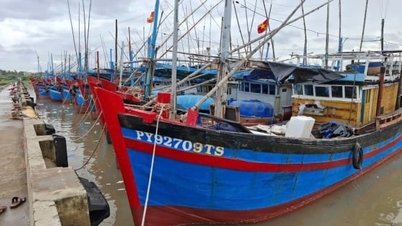
















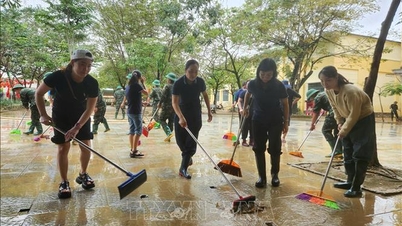
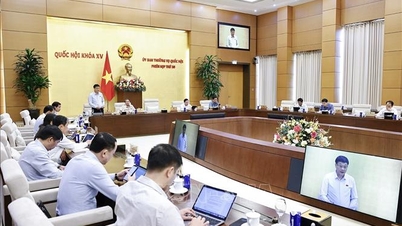

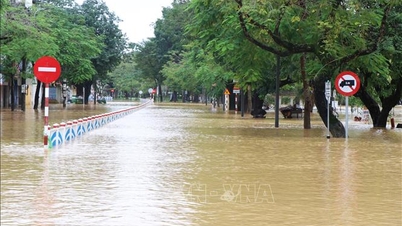




















































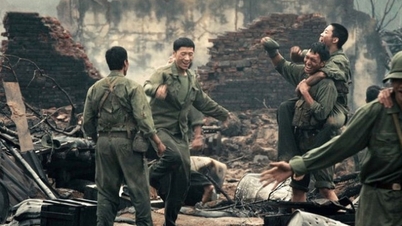
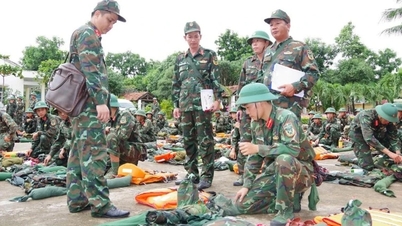














Comment (0)